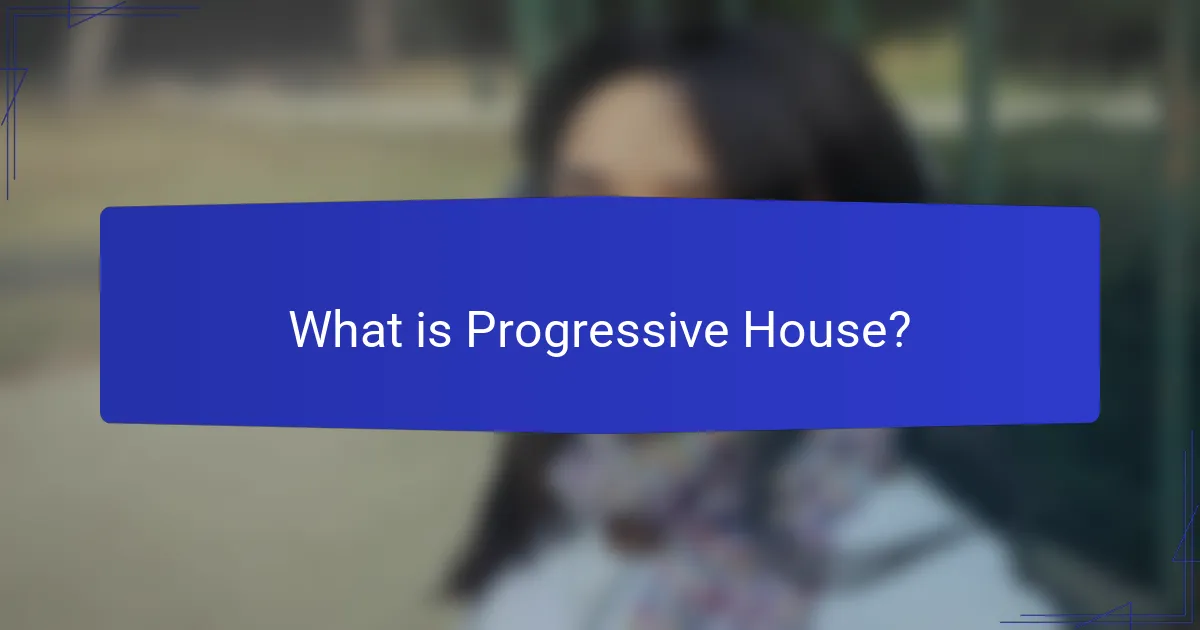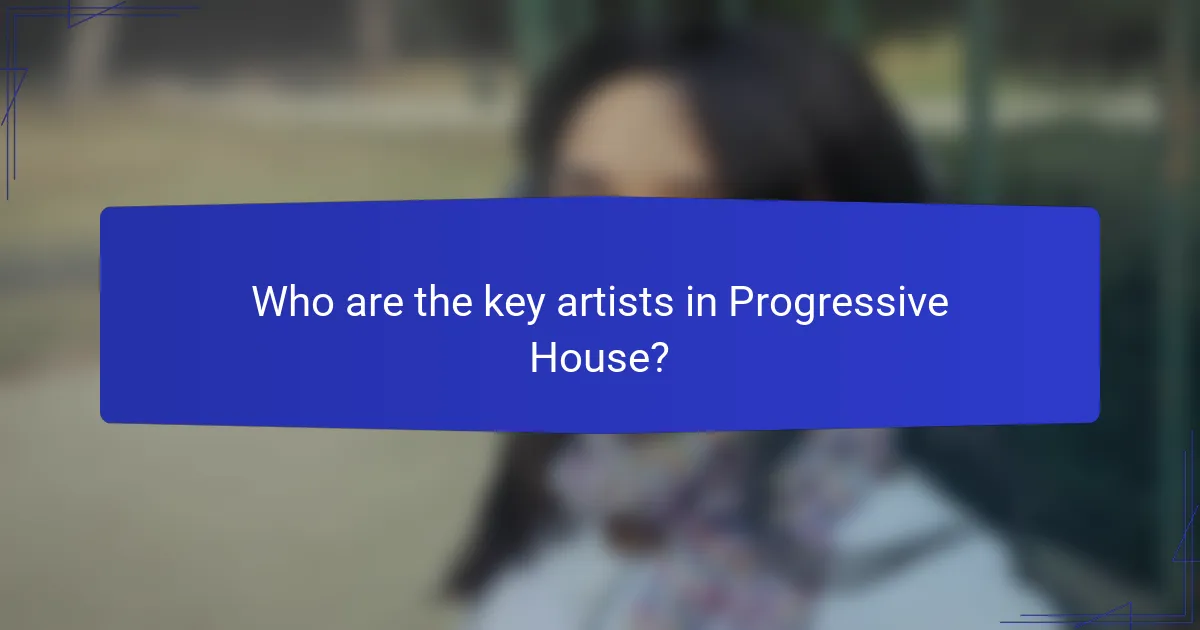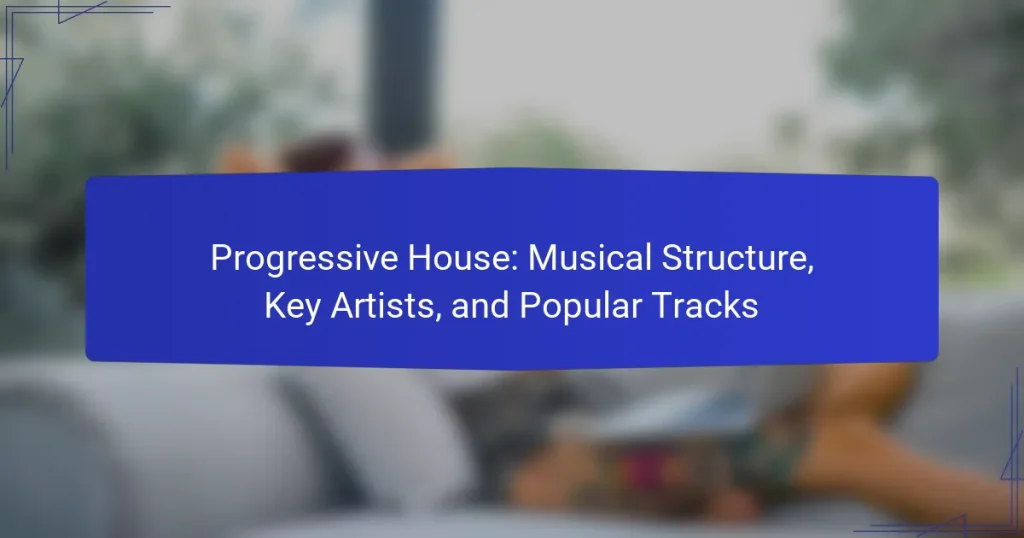Progressive House is a subgenre of electronic dance music known for its melodic and harmonic progression, characterized by a steady four-on-the-floor beat and atmospheric sounds. The genre has evolved since its rise to prominence in the 1990s, incorporating elements from trance and techno, and features key artists such as Sasha, John Digweed, and Eric Prydz. Popular tracks like “Strobe” by Deadmau5, “Sun & Moon” by Above & Beyond, and “Opus” by Eric Prydz exemplify the intricate arrangements and evolving melodies that define Progressive House. This article explores the musical structure of Progressive House, highlights influential artists, and discusses notable tracks that have shaped the genre.

What is Progressive House?
Progressive House is a subgenre of electronic dance music characterized by its melodic and harmonic progression. It typically features a steady four-on-the-floor beat and builds slowly over time. The genre emphasizes atmospheric sounds and layered synths, creating a deep and immersive listening experience. Progressive House often incorporates elements from other genres, including trance and techno. Key artists in this genre include Sasha, John Digweed, and Eric Prydz. Popular tracks often highlight evolving melodies and intricate arrangements. The genre gained prominence in the 1990s and has continued to influence modern electronic music.
How did Progressive House evolve over time?
Progressive House evolved from the early house music scene in the late 1980s. It incorporated elements of trance, techno, and ambient music. The genre gained popularity in the 1990s with artists like Sasha and John Digweed. Characterized by melodic structures and gradual build-ups, Progressive House emphasizes atmosphere and emotion. The sound has shifted over the years, integrating more diverse influences. In the 2000s, the genre saw a rise in commercial success with tracks from artists like Deadmau5 and Eric Prydz. Today, Progressive House continues to evolve, blending with other electronic music styles. Festivals and clubs worldwide feature this genre, showcasing its enduring appeal.
What are the historical influences on Progressive House music?
Progressive House music is influenced by various historical genres. It emerged in the late 1980s and early 1990s. The genre draws heavily from Chicago House and Detroit Techno. These earlier styles introduced a repetitive beat and synthesized sounds. The British electronic music scene also played a significant role. Artists like Sasha and John Digweed helped shape its sound. Progressive Trance contributed melodic elements and build-ups. The influence of ambient music added atmospheric textures. This blend of styles created the unique identity of Progressive House.
How has technology impacted the development of Progressive House?
Technology has significantly influenced the development of Progressive House. The advent of digital audio workstations (DAWs) has revolutionized music production. Artists can now create complex soundscapes with ease. MIDI technology allows for precise control over musical elements. This has enabled more intricate arrangements and layering of sounds. Software synthesizers have expanded the sonic palette available to producers. The rise of the internet has facilitated global collaboration among artists. Streaming platforms have also transformed how music is distributed and consumed. These technological advancements have shaped the sound and accessibility of Progressive House music.
What are the defining characteristics of Progressive House?
Progressive House is characterized by its melodic and atmospheric sound. It features gradual build-ups and breakdowns that create tension and release. The tempo typically ranges from 125 to 130 BPM. It often incorporates lush synths and deep basslines. Vocals are usually minimal and used sparingly. The genre emphasizes a journey-like experience through its extended track lengths. Key artists include Sasha, John Digweed, and Deadmau5, who have shaped its evolution. Progressive House has roots in the early 1990s, evolving from House and Trance influences.
What are the typical musical structures found in Progressive House?
Typical musical structures in Progressive House include a build-up, breakdown, and drop. The build-up creates anticipation through rising melodies and increasing energy. The breakdown often features softer elements, allowing for emotional release. The drop introduces the main theme with a strong beat and bassline. Additionally, Progressive House often employs a four-on-the-floor beat pattern. This rhythmic consistency supports the track’s flow. Tracks usually range from six to ten minutes in length, allowing for extended development. These structures contribute to the genre’s immersive experience, engaging listeners over time.
How do tempo and rhythm play a role in Progressive House tracks?
Tempo and rhythm are crucial in Progressive House tracks as they establish the foundational groove and energy. Typically, Progressive House features a tempo ranging from 125 to 130 beats per minute. This tempo allows for a steady, driving beat that encourages dancing and movement. Rhythm in these tracks is characterized by syncopation and layered patterns. These rhythmic elements create a sense of tension and release, enhancing the emotional experience. The interplay between tempo and rhythm builds anticipation throughout the track. Artists like Deadmau5 and Eric Prydz effectively utilize these elements to craft immersive soundscapes. The combination of consistent tempo and intricate rhythm patterns is essential in defining the Progressive House genre.
What makes Progressive House unique compared to other electronic genres?
Progressive House is unique due to its emphasis on melodic development and atmospheric soundscapes. This genre often features longer build-ups and breakdowns compared to other electronic genres. Tracks typically evolve gradually, creating an immersive listening experience. The use of complex chord progressions is another defining characteristic. Artists in this genre focus on creating emotional depth through music. Progressive House often incorporates elements from trance and house, blending their styles. Key artists like Sasha and John Digweed have shaped its sound. The genre’s popularity surged in the late 1990s and early 2000s, marking its distinct place in electronic music history.
What are the key elements that differentiate Progressive House from House music?
Progressive House is characterized by its complex structure and evolving sound. It typically features longer build-ups and breakdowns compared to standard House music. The tempo in Progressive House is often slightly slower, usually around 126 to 128 BPM. Progressive House incorporates atmospheric elements and layered melodies to create a more immersive experience. In contrast, House music tends to focus on repetitive beats and simpler arrangements. The use of synth pads and intricate soundscapes is more prevalent in Progressive House. Additionally, Progressive House often emphasizes emotional depth and storytelling within its tracks. These distinctions contribute to a unique listening experience that sets Progressive House apart from traditional House music.
How do Progressive House artists incorporate elements from other genres?
Progressive House artists incorporate elements from other genres by blending diverse musical styles and techniques. They often integrate melodic elements from trance, creating uplifting atmospheres. Additionally, they borrow rhythmic patterns from techno, enhancing danceability. Vocal samples from pop and rock genres are frequently used, adding familiarity to tracks. Some artists incorporate jazz influences through complex chord progressions. Others utilize ambient sounds from downtempo music, creating atmospheric layers. This genre fusion results in a rich, dynamic sound palette. The successful integration of these elements can be seen in tracks by artists like Sasha and John Digweed.

Who are the key artists in Progressive House?
Key artists in Progressive House include Sasha, John Digweed, and Eric Prydz. Sasha is known for his innovative mixing and production techniques. John Digweed has a significant influence on the genre with his deep, melodic tracks. Eric Prydz is recognized for his hit singles and immersive live performances. Other notable artists are Deadmau5, who blends various electronic styles, and Above & Beyond, known for their emotional soundscapes. These artists have shaped the Progressive House scene through their unique contributions and collaborations.
Which artists are considered pioneers of Progressive House?
Pioneers of Progressive House include Sasha, John Digweed, and Hernan Cattaneo. Sasha is known for his innovative mixing techniques and influential tracks. John Digweed has played a significant role in shaping the genre with his deep, melodic sound. Hernan Cattaneo is celebrated for his unique style and contributions to the Progressive House scene. These artists have helped define the genre since the 1990s through their performances and productions. Their work has inspired countless others and continues to influence electronic music today.
What contributions did these pioneers make to the genre?
Pioneers of progressive house significantly shaped the genre through innovative sound design and structure. They introduced complex melodies and layered textures that created a more immersive listening experience. Artists like Sasha and John Digweed popularized longer track lengths, allowing for gradual build-ups and emotional crescendos. Their DJ sets often featured seamless mixing techniques, enhancing the flow of music during live performances. Additionally, they incorporated elements from various genres, blending house with trance and techno. This cross-pollination expanded the audience and influence of progressive house. Their contributions set the foundation for future artists and defined the genre’s evolution in the 1990s and beyond.
How have newer artists influenced the sound of Progressive House?
Newer artists have significantly influenced the sound of Progressive House by incorporating diverse musical elements. They blend genres such as techno, trance, and ambient into their tracks. This fusion creates a richer sound palette. Artists like Lane 8 and Yotto have introduced melodic structures that emphasize emotional resonance. Their use of organic sounds contrasts with traditional electronic elements. Additionally, newer artists often focus on longer build-ups and atmospheric soundscapes. This approach enhances the immersive experience of Progressive House. The rise of streaming platforms has also allowed these artists to reach broader audiences. Consequently, the sound of Progressive House continues to evolve and diversify.
What are some notable collaborations in Progressive House?
Notable collaborations in Progressive House include “Strobe” by Deadmau5 and “In the Air” by Morgan Page featuring Angela McCluskey. Deadmau5’s “Strobe” is a landmark track known for its melodic progression and has influenced many artists. Morgan Page’s “In the Air” combines emotive vocals with a driving beat, showcasing the genre’s depth. Additionally, “I Remember” by Deadmau5 and Kaskade is another significant collaboration, blending their unique styles seamlessly. These collaborations exemplify the genre’s evolution and its impact on electronic music.
How do collaborations enhance the creativity within Progressive House?
Collaborations enhance creativity within Progressive House by merging diverse musical influences. Different artists bring unique styles and ideas to the table. This fusion leads to innovative soundscapes and fresh melodies. Collaborations often result in unexpected rhythmic patterns and harmonic progressions. For example, artists like Deadmau5 and Kaskade have created iconic tracks together. Their partnership combined elements of both their distinct sounds. This collaboration approach encourages experimentation and pushes creative boundaries. Ultimately, it enriches the Progressive House genre, making it more dynamic and engaging.
Which collaborations have had the most impact on the genre?
The collaborations that have had the most impact on the progressive house genre include those between Sasha and John Digweed. Their partnership in the 1990s revolutionized the sound of progressive house. Their album “Northern Exposure” is a landmark release that defined the genre’s direction. Another significant collaboration is between Eric Prydz and Steve Angello. Their track “Leave You Alone” showcased the blend of melodic elements and driving beats. Additionally, the duo of Deadmau5 and Kaskade created the iconic track “I Remember,” which became a defining anthem in the genre. These collaborations have shaped the sound and popularity of progressive house music.
How do artists promote their Progressive House music?
Artists promote their Progressive House music through various strategies. They utilize social media platforms to engage with fans. Platforms like Instagram, Facebook, and TikTok are popular for sharing music snippets. Artists often collaborate with influencers to reach wider audiences. Live performances and DJ sets are crucial for showcasing their music. Streaming services like Spotify and SoundCloud are essential for distribution. Many artists create music videos to enhance their visual appeal. They also participate in music festivals to gain exposure. Networking with other musicians can lead to collaborative projects and increased visibility.
What marketing strategies are effective for Progressive House artists?
Effective marketing strategies for Progressive House artists include leveraging social media platforms, engaging with fans through live streaming, and collaborating with other artists. Social media platforms like Instagram and TikTok allow artists to showcase their music and connect with a wider audience. Live streaming performances can create a sense of community and increase fan engagement. Collaborations with other artists can expand reach and introduce the artist to new fan bases. Data from the 2022 Music Industry Report indicates that artists who actively engage on social media see a 30% increase in fan interaction. Additionally, 70% of fans prefer discovering new music through collaborations, highlighting their effectiveness in marketing.
How do social media platforms influence the reach of Progressive House music?
Social media platforms significantly enhance the reach of Progressive House music. They provide artists with direct access to global audiences. Platforms like Instagram, Facebook, and TikTok allow for the sharing of music and visuals. This sharing increases exposure and engagement with fans. Additionally, algorithms on these platforms promote trending tracks to wider audiences. For example, TikTok has launched songs into viral status, impacting their streaming numbers. Data shows that tracks popular on social media often see a spike in plays on music streaming services. This interconnectedness between social media and music distribution amplifies the visibility of Progressive House artists.

What are the most popular tracks in Progressive House?
The most popular tracks in Progressive House include “Strobe” by Deadmau5, “Sun & Moon” by Above & Beyond, and “Opus” by Eric Prydz. “Strobe” is known for its melodic build and emotional depth. It has been a staple in festivals and clubs since its release in 2009. “Sun & Moon” features powerful vocals and a memorable drop, solidifying its place in the genre. Released in 2011, it has garnered millions of streams. “Opus,” released in 2016, showcases intricate production and a gradual build-up, making it a favorite among fans. These tracks are often highlighted in charts and playlists dedicated to Progressive House music.
Which tracks are considered classics in the Progressive House genre?
Classic tracks in the Progressive House genre include “Children” by Robert Miles, “Silence” by Delerium featuring Sarah McLachlan, and “For an Angel” by Paul van Dyk. “Children” was released in 1996 and became a global hit, shaping the sound of the genre. “Silence,” released in 1999, is renowned for its blend of ethereal vocals and deep beats. “For an Angel,” released in 1998, is a seminal track that defined the trance influence in Progressive House. These tracks are frequently cited in discussions about the genre’s evolution and enduring appeal.
What elements contribute to the popularity of these classic tracks?
Catchy melodies and memorable hooks contribute significantly to the popularity of classic tracks. These musical elements create an emotional connection with listeners. Strong basslines provide a rhythmic foundation that enhances danceability. The use of build-ups and drops creates anticipation and excitement during performances. High production quality ensures clarity and richness in sound, appealing to audiophiles. Iconic vocal samples often evoke nostalgia, resonating with fans of the genre. Collaborative efforts between renowned artists can amplify reach and credibility. Lastly, cultural impact through media exposure and live events helps solidify a track’s status in the music scene.
How have these tracks influenced the evolution of Progressive House?
Key tracks have significantly influenced the evolution of Progressive House. They introduced innovative soundscapes and complex melodies. Artists like Sasha and John Digweed pioneered these elements in the 1990s. Their tracks emphasized atmospheric build-ups and emotional depth. This approach shifted the genre from simple beats to intricate compositions. The incorporation of diverse influences expanded the genre’s appeal. Tracks such as “Xpander” by Sasha became iconic for their progressive structures. This evolution has led to a richer, more dynamic sound in contemporary Progressive House.
What are the current trending tracks in Progressive House?
Current trending tracks in Progressive House include “Inner Light” by Lane 8, “The Last Goodbye” by ODESZA featuring Bettye LaVette, and “Something About You” by Hayden James. These tracks have gained significant popularity on platforms like Beatport and Spotify. They showcase the genre’s characteristic melodic structure and deep basslines. Additionally, these tracks are frequently featured in DJ sets at major festivals. Their success reflects the ongoing evolution of Progressive House music.
How do current trends reflect the changing landscape of Progressive House?
Current trends in Progressive House showcase a shift towards melodic elements and deeper bass lines. This evolution reflects a growing preference for emotive soundscapes. Artists increasingly blend genres, incorporating elements from techno and ambient music. Collaborations between established and emerging artists are becoming more common. The use of technology in music production is also advancing. Software innovations allow for more intricate sound design. Streaming platforms influence the accessibility of tracks and artist exposure. Recent data shows a rise in listener engagement with atmospheric and cinematic styles.
What role do music festivals play in popularizing these tracks?
Music festivals play a crucial role in popularizing progressive house tracks. They provide a platform for artists to showcase their music to large audiences. Live performances create a unique experience that engages fans. Audiences often discover new tracks during these events. The communal atmosphere enhances the emotional connection to the music. Festivals also generate social media buzz, amplifying track visibility. According to a 2020 study by the International Music Summit, 70% of festival-goers reported discovering new music at events. This exposure significantly contributes to the tracks’ popularity and streaming success.
How can listeners discover new Progressive House music?
Listeners can discover new Progressive House music through various platforms and methods. Streaming services like Spotify and Apple Music offer curated playlists featuring new releases. These platforms often have algorithms that suggest tracks based on listening habits. Social media platforms, especially Instagram and TikTok, showcase emerging artists and tracks through short video clips. Following Progressive House music labels on these platforms can also provide updates on new music. Additionally, music blogs and websites dedicated to electronic music often review and highlight new Progressive House tracks. Attending live events and festivals can expose listeners to new artists and sounds in the genre. Finally, joining online communities and forums can help fans stay informed about new releases and trends in Progressive House music.
What platforms are best for exploring new Progressive House releases?
Spotify is one of the best platforms for exploring new Progressive House releases. It offers curated playlists like “Mint” and “Dance Hits” that feature the latest tracks. SoundCloud is another excellent platform, known for its user-uploaded content and emerging artists. Beatport specializes in electronic music, providing a comprehensive catalog of new releases and charts. Apple Music also features curated playlists and new release notifications for Progressive House. Additionally, YouTube allows users to discover new tracks through channels dedicated to electronic music. These platforms collectively provide a wide range of options for fans to stay updated on new releases in the Progressive House genre.
How can playlists enhance the listening experience for Progressive House fans?
Playlists enhance the listening experience for Progressive House fans by curating a continuous flow of tracks that maintain energy and mood. This genre often features long, evolving build-ups and intricate melodies. A well-structured playlist can seamlessly transition between these elements, creating an immersive experience. Playlists also allow fans to discover new artists and tracks within the Progressive House scene. By grouping similar styles or themes, playlists can introduce listeners to a broader spectrum of sounds. Additionally, playlists can cater to specific occasions, such as workouts or relaxation, enhancing their relevance. Data shows that curated playlists increase listener engagement by up to 30%. This demonstrates their effectiveness in enriching the overall musical experience.
Progressive House is a subgenre of electronic dance music known for its melodic progression, atmospheric sounds, and layered synths. This article explores the defining characteristics of Progressive House, its evolution from early house music, and the historical influences that shaped its sound. Key artists such as Sasha, John Digweed, and Eric Prydz are highlighted for their contributions, along with notable collaborations and popular tracks that exemplify the genre’s depth. Additionally, the impact of technology and current trends in Progressive House music are discussed, providing insights into how listeners can discover new releases and engage with the genre.

